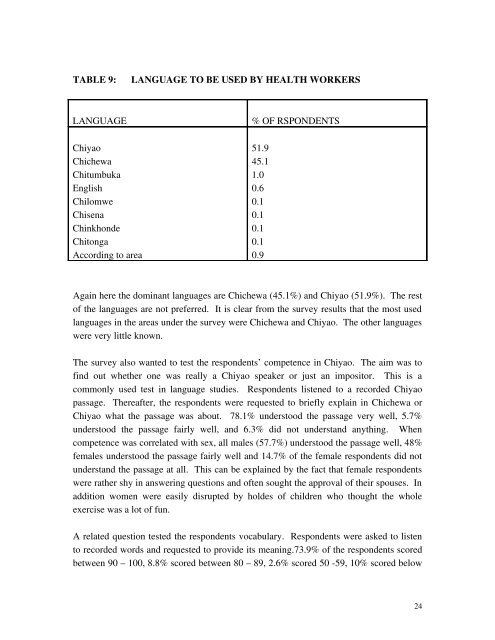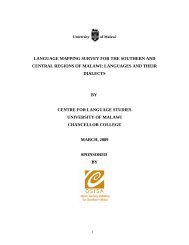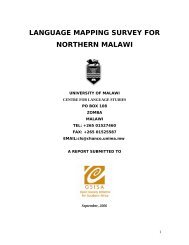SOCIOLOLINGUISTIC SURVEYS - Centre for Language Studies
SOCIOLOLINGUISTIC SURVEYS - Centre for Language Studies
SOCIOLOLINGUISTIC SURVEYS - Centre for Language Studies
Create successful ePaper yourself
Turn your PDF publications into a flip-book with our unique Google optimized e-Paper software.
TABLE 9:<br />
LANGUAGE TO BE USED BY HEALTH WORKERS<br />
LANGUAGE<br />
% OF RSPONDENTS<br />
Chiyao<br />
Chichewa<br />
Chitumbuka<br />
English<br />
Chilomwe<br />
Chisena<br />
Chinkhonde<br />
Chitonga<br />
According to area<br />
51.9<br />
45.1<br />
1.0<br />
0.6<br />
0.1<br />
0.1<br />
0.1<br />
0.1<br />
0.9<br />
Again here the dominant languages are Chichewa (45.1%) and Chiyao (51.9%). The rest<br />
of the languages are not preferred. It is clear from the survey results that the most used<br />
languages in the areas under the survey were Chichewa and Chiyao. The other languages<br />
were very little known.<br />
The survey also wanted to test the respondents’ competence in Chiyao. The aim was to<br />
find out whether one was really a Chiyao speaker or just an impositor. This is a<br />
commonly used test in language studies. Respondents listened to a recorded Chiyao<br />
passage. Thereafter, the respondents were requested to briefly explain in Chichewa or<br />
Chiyao what the passage was about. 78.1% understood the passage very well, 5.7%<br />
understood the passage fairly well, and 6.3% did not understand anything. When<br />
competence was correlated with sex, all males (57.7%) understood the passage well, 48%<br />
females understood the passage fairly well and 14.7% of the female respondents did not<br />
understand the passage at all. This can be explained by the fact that female respondents<br />
were rather shy in answering questions and often sought the approval of their spouses. In<br />
addition women were easily disrupted by holdes of children who thought the whole<br />
exercise was a lot of fun.<br />
A related question tested the respondents vocabulary. Respondents were asked to listen<br />
to recorded words and requested to provide its meaning.73.9% of the respondents scored<br />
between 90 – 100, 8.8% scored between 80 – 89, 2.6% scored 50 59, 10% scored below<br />
24





